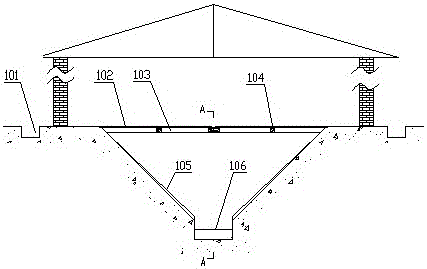System and method for controlling excrement and urine of poultries and placentae of disease-caused dead poultries in large-scale farm
A technology for dead livestock and poultry and farms, which is applied to the pollution control system of large-scale livestock and poultry feces liquid and placenta of dead livestock and poultry, liquid organic fertilizer and solid organic fertilizer, and can solve the problem of extremely high equipment requirements and easy Spoilage, low nutrient content in dry matter, etc.
- Summary
- Abstract
- Description
- Claims
- Application Information
AI Technical Summary
Problems solved by technology
Method used
Image
Examples
Embodiment 1
[0070] Treatment of livestock and poultry manure and urine in large-scale breeding farms without diseases and dead animals and placenta:
[0071] (1) The livestock and poultry houses block rainwater, and the rainwater is timely drained through the drainage ditch 101 outside the house to realize the separation of rain and sewage; when the livestock and poultry drink water, the water leaking from the automatic drinking fountains and the mouth of the livestock and poultry falls into the U-shaped water collection. In the cavities, and discharged to the drainage ditch 101 outside the house in time through the drainage pipe, the drinking and sewage are separated; the daily excrement (feces and urine) of livestock and poultry leaks from the slatted floor 102 and falls on the inverted sloping surface On 105 or in the manure removal ditch 106, the feces and urine falling on the inverted eight-shaped slope surface 105 naturally slide into the manure removal ditch 106 under the action of gra...
Embodiment 2
[0082] Treatment of livestock and poultry manure and urine in large-scale farms with sick and dead livestock and placenta:
[0083] (1) The livestock and poultry houses block rainwater, and the rainwater is timely drained through the drainage ditch 101 outside the house to realize the separation of rain and sewage; when the livestock and poultry drink water, the water leaking from the automatic drinking fountains and the mouth of the livestock and poultry falls into the U-shaped water collection. In the cavities, and discharged to the drainage ditch 101 outside the house in time through the drainage pipe, the drinking and sewage are separated; the daily excrement (feces and urine) of livestock and poultry leaks from the slatted floor 102 and falls on the inverted sloping surface On 105 or in the manure removal ditch 106, the feces and urine falling on the inverted eight-shaped slope surface 105 naturally slide into the manure removal ditch 106 under the action of gravity. The manu...
Embodiment 3
[0096] (1) The livestock and poultry houses block rainwater, and the rainwater is timely drained through the drainage ditch 101 outside the house to realize the separation of rain and sewage; when the livestock and poultry drink water, the water leaking from the automatic drinking fountains and the mouth of the livestock and poultry falls into the U-shaped water collection. In the cavities, and drained to the drainage ditch 101 outside the house in time through the drainage pipe, the drinking and sewage are separated; the daily excrement (feces and urine) of livestock and poultry leaks from the slatted floor 102 and falls on the inverted sloping surface On 105 or in the manure removal ditch 106, the feces and urine falling on the inverted eight-shaped slope surface 105 naturally slide into the manure removal ditch 106 under the action of gravity. The manure scraping system is activated regularly every day, and the driving device 107 is driven by the driving rope 110 The manure s...
PUM
 Login to View More
Login to View More Abstract
Description
Claims
Application Information
 Login to View More
Login to View More - R&D
- Intellectual Property
- Life Sciences
- Materials
- Tech Scout
- Unparalleled Data Quality
- Higher Quality Content
- 60% Fewer Hallucinations
Browse by: Latest US Patents, China's latest patents, Technical Efficacy Thesaurus, Application Domain, Technology Topic, Popular Technical Reports.
© 2025 PatSnap. All rights reserved.Legal|Privacy policy|Modern Slavery Act Transparency Statement|Sitemap|About US| Contact US: help@patsnap.com



